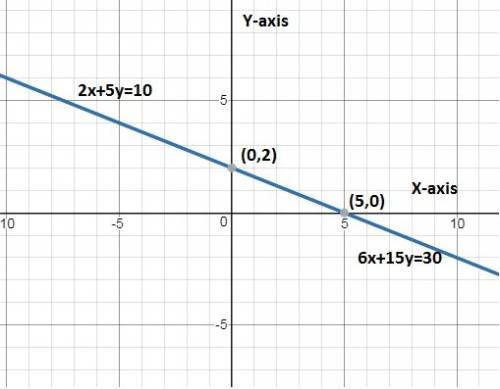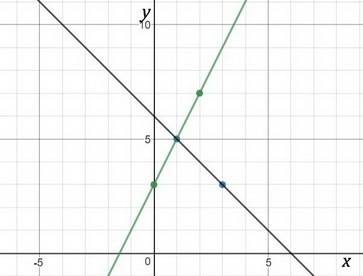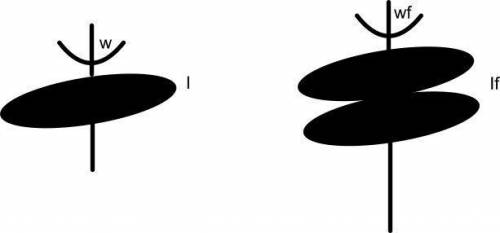 4
4 The answer is NO.
Step-by-step explanation: The given statement is -
If the graph of two equations are coincident lines, then that system of equations will have no solution.
We are to check whether the above statement is correct or not.
Any two equations having graphs as coincident lines are of the form -

If we take d = 1, then both the equations will be same.
Now, subtracting the second equation from first, we have

Again, we will get the first equation, which is linear in two unknown variables. So, the system will have infinite number of solutions, which consists of the points lying on the line.
For example, see the attached figure, the graphs of following two equations is drawn and they are coincident. Also, the result is again the same straight line which has infinite number of points on it. These points makes the solution for the following system.

Thus, the given statement is not correct.

 4
4 The answer is NO.
Step-by-step explanation: The given statement is -
If the graph of two equations are coincident lines, then that system of equations will have no solution.
We are to check whether the above statement is correct or not.
Any two equations having graphs as coincident lines are of the form -

If we take d = 1, then both the equations will be same.
Now, subtracting the second equation from first, we have

Again, we will get the first equation, which is linear in two unknown variables. So, the system will have infinite number of solutions, which consists of the points lying on the line.
For example, see the attached figure, the graphs of following two equations is drawn and they are coincident. Also, the result is again the same straight line which has infinite number of points on it. These points makes the solution for the following system.

Thus, the given statement is not correct.

 4
4 (A) y - 7 = 2(x -2)
(B) y = -x + 6; y - 5 = -1(x + 1)
(C) Consistent independent
(D) (1, 5)
Step-by-step explanation:
(A) Road 1
(a) Slope
The point-slope formula for a straight line is
y₂ - y₁ = m(x₂ - x₁) Insert the points
3 - 7 = m(0 - 2)
-4 = m(-2) Divide each side by -2
m = -4/(-2) Divide numerator and denominator by-2,
m = 2
=====
(b) y-intercept
y₂ - y₁ = m(x₂ - x₁)
y₂ - 7 = 2(x₂ -2)
y - 7 = 2(x -2)
===============
(B) Road 2
(a) Slope
y = mx + b
Choose point (3,3)
m = (3 - 5)/(3 - 1)
m = -2/2
m = -1
=====
(b) y-intercept
y = mx +b
Choose point (3,3).
3 = -3 + b Add 3 to each side
b = 6
=====
(c) Equation of line (point-slope form)
y = mx + b
y = -x + 6
=====
(d) Equation of line (slope-intercept form)
y - 5 = -1(x - 1)
===============
(C) Consistency
The two roads intersect.
There is only one point of intersection, so this is a consistent, independent system of equations
===============
(D) Point of intersection
(1) y - 7 = 2(x - 2)
(2) y = -x + 6 Substitute (2) into (1)
-x + 6 – 7 = 2(x – 2) Remove parentheses
-x - 1 = 2x – 4 Add 4 to each side
-x +3 = 2x Add x to each side
3 = 3x Divide each side by 3
x = 1 Substitute into 2
=====
y = -1 + 6
y = 5
The point of intersection is (1, 5).

 4
4 (A) y - 7 = 2(x -2)
(B) y = -x + 6; y - 5 = -1(x + 1)
(C) Consistent independent
(D) (1, 5)
Step-by-step explanation:
(A) Road 1
(a) Slope
The point-slope formula for a straight line is
y₂ - y₁ = m(x₂ - x₁) Insert the points
3 - 7 = m(0 - 2)
-4 = m(-2) Divide each side by -2
m = -4/(-2) Divide numerator and denominator by-2,
m = 2
=====
(b) y-intercept
y₂ - y₁ = m(x₂ - x₁)
y₂ - 7 = 2(x₂ -2)
y - 7 = 2(x -2)
===============
(B) Road 2
(a) Slope
y = mx + b
Choose point (3,3)
m = (3 - 5)/(3 - 1)
m = -2/2
m = -1
=====
(b) y-intercept
y = mx +b
Choose point (3,3).
3 = -3 + b Add 3 to each side
b = 6
=====
(c) Equation of line (point-slope form)
y = mx + b
y = -x + 6
=====
(d) Equation of line (slope-intercept form)
y - 5 = -1(x - 1)
===============
(C) Consistency
The two roads intersect.
There is only one point of intersection, so this is a consistent, independent system of equations
===============
(D) Point of intersection
(1) y - 7 = 2(x - 2)
(2) y = -x + 6 Substitute (2) into (1)
-x + 6 – 7 = 2(x – 2) Remove parentheses
-x - 1 = 2x – 4 Add 4 to each side
-x +3 = 2x Add x to each side
3 = 3x Divide each side by 3
x = 1 Substitute into 2
=====
y = -1 + 6
y = 5
The point of intersection is (1, 5).

a) The sketch is attached.
b) The angular speed of the new system is 3 rad/s
c) The angular speed of the new system is 2 rad/s
Explanation:
b) The angular speed of the system is:

Where
Ii = I
If = I + I
wi = 6 rad/s
Replacing:

c) If a third disk is dropped, the angular speed is:


 10
10 If a graph of a system of two equations shows two lines that coincide on a coordinate plan there would be C.)Infinitely many solutions
I hope this helps, have a great day.
a) The sketch is attached.
b) The angular speed of the new system is 3 rad/s
c) The angular speed of the new system is 2 rad/s
Explanation:
b) The angular speed of the system is:

Where
Ii = I
If = I + I
wi = 6 rad/s
Replacing:

c) If a third disk is dropped, the angular speed is:


 10
10 If a graph of a system of two equations shows two lines that coincide on a coordinate plan there would be C.)Infinitely many solutions
I hope this helps, have a great day.
 12
12 
It will provide an instant answer!
